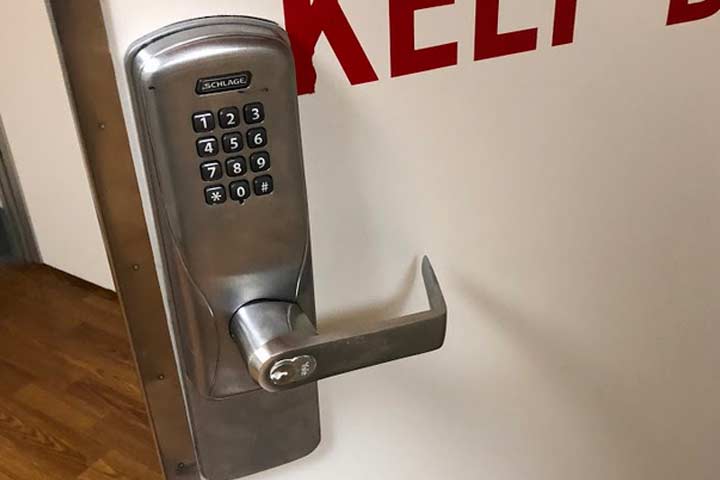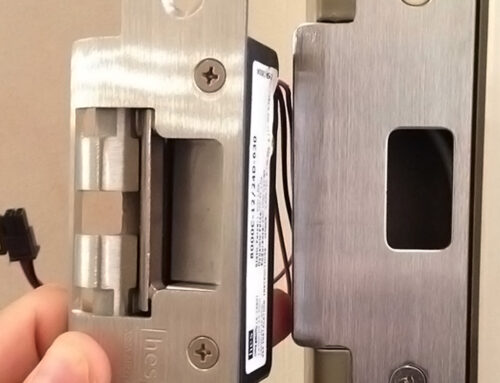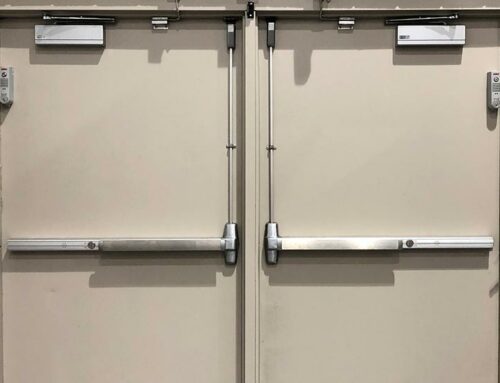Hardware is what makes your security door secure. Different hardware can resist different threats and keep unauthorized people out of the facility. Other types of hardware make it easier for authorized people to enter the door, without sacrificing its ability to discourage and repel intruders. If you need a truly secure door, it’s wise to take some time to learn about the basic security door hardware types and get a sense of which you might need for your door.
Hinges and Pins
While we often think about locks as the most basic type of hardware, hinges and pins are really the most basic parts, as every door must have them. And, if a door’s hinges can be dismantled, then the lock may not matter at all.
- Non-removable pins: This clever pin design makes it impossible for someone to pry the pin out. To get in, the need to cut into the hinge itself.
- Security tabs: When the door is closed, the pins and hinges are usually exposed. Security tabs fuse the two parts of the hinge together. If someone takes out the pins, the door doesn’t just fall open. Instead, they would need to pry the door and frame apart still.
- Continuous hinges: This is usually our preferred option for security door hinges. These prevent even prying of the door because they run the length of the door. Instead, to get in, someone would need to cut the hinge the whole length of the door.
Basic Locks
Of course, the lock is an essential feature of any security door. We offer sophisticated access control systems. However, you still may be interested in simpler physical locks, or those that use a manual key. If so, consider these:
- Chain locks: Most common in apartment buildings, chain locks are simple to use.
- Barrel locks: Barrel locks offer the same ease of use, with a barrel that can be notched into place.
- Swing bar locks: A more secure form of the chain lock, swing bars are still simple to use.
- Mortise lock: Mortise locks are simply those that we need to install inside the door, instead of adding it on the outside. They are significantly more secure than the locks we’ve discussed so far.
- Cylindrical locks: Cylindrical locks are more convenient to install than mortise locks, as we can simply drill a hole in the door and get started, while mortise locks need a whole pocket in the door. Your typical household door has a cylindrical lock and deadbolt.
Are you wondering which kind of lock is easiest to change out? If you are changing locks in your security door frequently, we recommend IC Cores, also called interchangeable cores. These locks have a central core that can be easily removed and replaced with a new lock.
Door Reinforcements
Sometimes you need to add additional strength to a door to prevent people from knocking it down in their attempts to get inside. Often a door that feels firmer or has obvious reinforcement is enough deterrence on its own. Here are some options to reinforce your security door:
- Security bars: A security bar can add considerable strength to a door. Some security doors come with built-in steel bars for this purpose. A security bar is one area where you really need a professional’s opinion, as not all bars offer the strength you may expect.
- Reinforcement plates: These plates are designed to sit around cylindrical locks. They help prevent people from cutting into the wood of the door to remove the lock. Of course, if you have a steel security door in the first place, these plates are unnecessary.
- Removable mullions: A mullion is a tall bar that divides two doors and supports them both. This extra security and strength is helpful but may get in the way if you need to move large objects or materials through the door. That’s why we offer removable mullions that you can take down if you need to get something large through the door.
Access Control Systems
Manual locks can only be so secure and aren’t always convenient. A strong access control system is a smart addition to any security door. Ideally, it would combine secure hardware with sophisticated software, allowing your staff or other authorized people to enter any door they need to, while denying entry to others.
We trust the Openpath access control system. It allows for touchless entry, with three open signals for redundancy, so that it opens every time. The hardware itself is durable and streamlined. It looks modern and comes in various sizes so that you have room for it next to any door.
Exit Devices
Security doors may also need hardware to make exiting through the safer and simpler. Here are some hardware options for that purpose:
- Door closers: A door that’s open isn’t secure at all. You may not want to rely on your employees or other guests to close the door after themselves. Automatic door closers will do it for them, so you know that no one can bypass the door.
- Push bars: Security doors, especially metal ones, can be heavy. It is often wise to install push bars on the inside of the doors to allow people to exit more easily. Sometimes, exit devices are mandated by local fire codes. In this case, they may need to trigger an alarm to signal a fire.
Weatherstripping
Security doors are often exterior doors, which means that they need weatherstripping to keep the summer heat or winter cold out of your building. Steel doors often have two types of weather stripping, one along the side of the door and one along the bottom of the door. Weatherstripping may be made of various materials, including foam and rubber. Some exterior doors have a brush-like weather stripping that helps the door seal even over irregular surfaces.
What door hardware do you need? Every business has different needs for their security doors, so the best way to find out is to speak with a local security door installation specialist in your area.







